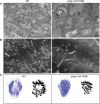Mitochondrial DNA level, but not active replicase, is essential for Caenorhabditis elegans development
- PMID: 19181702
- PMCID: PMC2665216
- DOI: 10.1093/nar/gkp018
Mitochondrial DNA level, but not active replicase, is essential for Caenorhabditis elegans development
Abstract
A number of studies showed that the development and the lifespan of Caenorhabditis elegans is dependent on mitochondrial function. In this study, we addressed the role of mitochondrial DNA levels and mtDNA maintenance in development of C. elegans by analyzing deletion mutants for mitochondrial polymerase gamma (polg-1(ok1548)). Surprisingly, even though previous studies in other model organisms showed necessity of polymerase gamma for embryonic development, homozygous polg-1(ok1548) mutants had normal development and reached adulthood without any morphological defects. However, polg-1 deficient animals have a seriously compromised gonadal function as a result of severe mitochondrial depletion, leading to sterility and shortened lifespan. Our results indicate that the gonad is the primary site of mtDNA replication, whilst the mtDNA of adult somatic tissues mainly stems from the developing embryo. Furthermore, we show that the mtDNA copy number shows great plasticity as it can be almost tripled as a response to the environmental stimuli. Finally, we show that the mtDNA copy number is an essential limiting factor for the worm development and therefore, a number of mechanisms set to maintain mtDNA levels exist, ensuring a normal development of C. elegans even in the absence of the mitochondrial replicase.
Figures





References
-
- Kaguni LS. DNA polymerase gamma, the mitochondrial replicase. Annu. Rev. Biochem. 2004;73:293–320. - PubMed
-
- Trifunovic A, Wredenberg A, Falkenberg M, Spelbrink JN, Rovio AT, Bruder CE, Bohlooly-Y M, Gidlöf S, Oldfors A, Wibom R, et al. Premature ageing in mice expressing defective mitochondrial DNA polymerase. Nature. 2004;429:417–423. - PubMed
-
- Hudson G, Chinnery PF. Mitochondrial DNA polymerase-gamma and human disease. Hum. Mol. Genet. 2006;15:R244–R252. - PubMed
-
- Longley MJ, Graziewicz MA, Bienstock RJ, Copeland WC. Consequences of mutations in human DNA polymerase gamma. Gene. 2005;354:125–131. - PubMed
-
- Genga A, Bianchi L, Foury F. A nuclear mutant of Saccharomyces cerevisiae deficient in mitochondrial DNA replication and polymerase activity. J. Biol. Chem. 1986;261:9328–9332. - PubMed
Publication types
MeSH terms
Substances
Grants and funding
LinkOut - more resources
Full Text Sources
Other Literature Sources
Molecular Biology Databases
Research Materials

